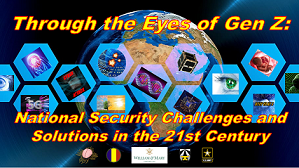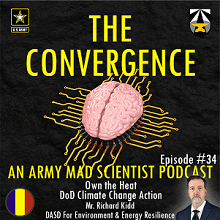[Editor’s Note: In continuing the Mad Scientist Initiative’s recent focus on climate change and its implications for the U.S. Army, we are pleased to feature proclaimed Mad Scientist Mr. Richard G. Kidd IV, Deputy Assistant Secretary of Defense for Environment & Energy Resilience, in this latest episode of The Convergence podcast, addressing threats to the force from climate change, operating conditions in a worsening climate, and how the Department of Defense (DoD) can be proactive in this existential fight — Enjoy! (Please note that this podcast and several of the embedded links below are best accessed via a non-DoD network due to network priorities for teleworking)]
[If the podcast dashboard is not rendering correctly for you, please click here to listen to the podcast]
Mr. Richard G. Kidd IV, Deputy Assistant Secretary of Defense for Environment & Energy Resilience, provides policy and governance for programs and activities that enable resilience and cyber-secure energy for weapon systems and installations. This includes budgetary, policy, and management oversight of programs related to climate change, compliance with environmental laws, prevention of pollution, management of natural and cultural resources, and cleanup of contaminated sites, as well as energy resilience, risk, and performance. Prior to his current position, Mr. Kidd served as the Deputy Assistant Secretary of the Army for Strategic Integration where he led the strategy development, resource requirements, and overall business transformation processes for the Office within the Office of the Assistant Secretary of the Army for Installations, Energy and Environment. He was responsible for developing and monitoring performance metrics for the Army’s installation management community as well as leading a strategic effort to examine options for future Army installations.
Deputy Assistant Secretary of Defense for Environment & Energy Resilience, provides policy and governance for programs and activities that enable resilience and cyber-secure energy for weapon systems and installations. This includes budgetary, policy, and management oversight of programs related to climate change, compliance with environmental laws, prevention of pollution, management of natural and cultural resources, and cleanup of contaminated sites, as well as energy resilience, risk, and performance. Prior to his current position, Mr. Kidd served as the Deputy Assistant Secretary of the Army for Strategic Integration where he led the strategy development, resource requirements, and overall business transformation processes for the Office within the Office of the Assistant Secretary of the Army for Installations, Energy and Environment. He was responsible for developing and monitoring performance metrics for the Army’s installation management community as well as leading a strategic effort to examine options for future Army installations.
In today’s podcast, Mr. Kidd addresses threats to the force from climate change, operating conditions in a worsening climate, and how the DoD can be proactive in this existential fight. The following bullet points highlight key insights from our discussion:
-
-
- Climate change presents an inevitable threat to world peace, economic prosperity, and capital investment. It is likely to impact the U.S. military in three major ways:
-
-
-
-
- Increased Operational Requirements: Climate change will overwhelm the governing capacity of weak states, increasing conflict and extremism abroad and subsequently increasing foreign threats. Domestically, demand for the Army National Guard, the Corps of Engineers, and civil authorities will increase in responding to and preventing damage from severe weather.
-
-
-
-
-
- Increased Vulnerability of Installations: Prevalence and intensity of floods, erosion, drought, fires, wind shear, and sea level rise will grow as a result of climate change, threatening military installations.
-
-
-
-
-
- Degradation of Performance: Performance parameters of both people and equipment will be challenged as they are forced to operate in extreme temperatures. Keeping Soldiers alive in an increasingly hostile climate will challenge the U.S. Army.
-
-
-
-
- U.S. adversaries will craft strategic narratives to criticize U.S. action, or inaction, on climate change. China has heralded, and indeed, ‘weaponized’ its own prioritization of climate change policy and technology development, highlighting its actions in contrast to previous U.S. failures to engage in the Paris Accords. Despite this element of competition, the United States should cooperate with China on climate change policy, given the two nations’ significant impact on the environment.
-
-
-
- Through a series of executive orders, and specifically via EO14008, the Biden administration has established climate change as a priority, putting the climate crisis at the center of U.S. Foreign Policy and National Security. Policies such as setting a goal of net zero carbon emissions by 2050 will require the DoD to plan to reduce emissions and build climate awareness into every level of the Joint force. Finding innovative solutions to address legacy weapons systems’ emissions will be an on-going challenge. Creating solutions by leveraging experts and relevant data will be essential to DoD’s success in addressing this challenge.
-
-
-
- In order to manage the existential threat posed by climate change, the U.S. Army and DoD must prepare strategies for both adaptation and mitigation. Adapting to climate change will focus on ‘managing the unavoidable’ aspects of climate change, such as building sea walls, developing new land use patterns, and moving vulnerable power lines underground. On the other hand, mitigating climate change will focus on ‘avoiding the unmanageable’ by reducing current greenhouse gas emissions.
-
-
-
- Adaptation and mitigation strategies can overlap. The development of cyber-secure micro grids with on-site power generation can protect against a range of threats, whether from adversarial cyber-attacks or extreme weather events, enhancing overall installation resiliency, while reducing carbon emissions.
-
-
-
- Short term solutions will focus on increased efficiencies, while long term solutions will dramatically reduce fuel consumption via promising new technologies and innovation. These include: incorporation of winglets on fixed wing aircraft, hybridization of vehicles, on-site solar power generation, super efficient solar cell technologies capable of beaming power from point-to-point, and small modular nuclear reactors — “You can’t be concerned about climate change and be opposed to nuclear power.”
-
-
-
- The U.S. military should prioritize ways to ‘own the heat,’ mirroring former initiatives to develop advanced night vision technology. Technology development in this arena will involve creating tactical cooling systems, increasing vehicle performance, developing individual Soldier cooling solutions, and increasing their medical monitoring.
-
-
-
- Advanced technology for operating in extreme temperatures could provide the United States with a strategic advantage in conflict. Emphasizing DoD climate awareness and efforts to mitigate military environmental impacts will help the Army recruit the next generation of Soldiers, who are increasingly impacted by climate change and interested in climate solutions. Conversely, “If we as a military are not addressing climate change, if we’re not serious about this, we’re going to lose appeal to many future Soldiers… They’re going to say, ‘If the military is not onboard with climate change, I don’t want to serve.’“
-

Stay tuned to the Mad Scientist Laboratory for our next episode of “The Convergence,” featuring an interview with bestselling author Gayle Tzemach Lemmon, discussing writing about disruptors, the emergence of female fighters and military leaders, and the future of women on the battlefield.
The DoD’s Tackling the Climate Crisis web page, referred to by Mr. Kidd at the end of the podcast, may be accessed here. If you enjoyed this post, check out the following related content:
Mad Scientist’s Climate Change – Threats, Resilience, and Adaptation webinar guest panelists’ biographies and their slide decks here, and watch the entire video of the event here [access via a non-DoD network]
The Inevitable Threat: Climate Change and the Operational Environment
“The Heat is On” in “The Queue” Redux!
Climate Change as a Threat Multiplier, by LTCOL Nathan Pierpoint, Australian Army
Climate Change: Destroyer of World, by CPT Kyle Hallowell, U.S. Army
Climate Change Laid Bare: Why We Need To Act Now, by proclaimed Mad Scientist Sage Miller
Water: A Fluid Challenge for the Future, by proclaimed Mad Scientist Caroline Duckworth
 >>>REMINDER 1: Mad Scientist’s next virtual event — Through the Eyes of Gen Z: National Security Challenges and Solutions in the 21st Century — is this afternoon, Thursday, 29 April 2021 (starting at 1300 EDT). Join us as we collaborate again with The College of William and Mary’s Project on International Peace and Security (PIPS) Program to broaden our aperture on the Operational Environment (OE). We will host two moderated discussion panels where PIPS Research fellows discuss the ramifications of their respective research topics on the OE and the changing character of competition, conflict, and U.S. strategy.
>>>REMINDER 1: Mad Scientist’s next virtual event — Through the Eyes of Gen Z: National Security Challenges and Solutions in the 21st Century — is this afternoon, Thursday, 29 April 2021 (starting at 1300 EDT). Join us as we collaborate again with The College of William and Mary’s Project on International Peace and Security (PIPS) Program to broaden our aperture on the Operational Environment (OE). We will host two moderated discussion panels where PIPS Research fellows discuss the ramifications of their respective research topics on the OE and the changing character of competition, conflict, and U.S. strategy.
Check out the event flyer here, then register here NOW [via a non-DoD network] to participate in this informative event.
In the meantime, check out what we learned from last year’s event in GEN Z and the OE: 2020 Final Findings to whet your appetite for our upcoming event!
 >>>REMINDER 2: Young Minds on Competition and Conflict, the next webinar in our continuing series of Are We Doing Enough, Fast Enough? virtual events – explores our adversaries’ views on Competition, Crisis, Conflict, and Change on Thursday, 6 May 2021 (starting at 1000 EDT). Join our panel of prominent young minds from the national security arena as they share their ideas about the future of competition and conflict for the next decade. Register here now [via a non-DoD network] to participate in this informative event.
>>>REMINDER 2: Young Minds on Competition and Conflict, the next webinar in our continuing series of Are We Doing Enough, Fast Enough? virtual events – explores our adversaries’ views on Competition, Crisis, Conflict, and Change on Thursday, 6 May 2021 (starting at 1000 EDT). Join our panel of prominent young minds from the national security arena as they share their ideas about the future of competition and conflict for the next decade. Register here now [via a non-DoD network] to participate in this informative event.



